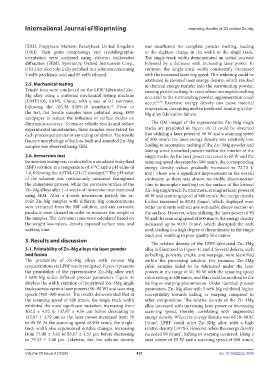Page 439 - IJB-10-4
P. 439
International Journal of Bioprinting Improving ductility of 3D-printed Zn–Mg
(XRD, Empyrean, Malvern Panalytical, United Kingdom was insufficient for complete powder melting, leading
[UK]). Their grain morphology and crystallographic to the slightest change in the width of the single track.
orientation were analyzed using electron backscatter The single-track width demonstrated an initial increase
diffraction (EBSD, Symmetry, Oxford Instrument Corp., followed by a decrease with increasing laser power. In
UK) after electrolytically polished in a solution containing contrast, the single-track width consistently decreased
5 vol% perchloric acid and 95 vol% ethanol. with the increased scanning speed. This widening could be
attributed to elevated laser energy density, which resulted
2.5. Mechanical testing in thermal energy transfer into the surrounding powder,
Tensile tests were conducted on the LPBF-fabricated Zn– causing partial melting. In cases where incomplete melting
Mg alloy using a universal mechanical testing machine occurred to the surrounding powder, agglomeration could
(CMT5105, SANS, China) with a rate of 0.1 mm/min, occur. 36,37 Excessive energy density can cause material
following the ASTM E209-18 standards. Prior to evaporation, disrupting molten pools and resulting in Zn–
34
the test, the tensile samples were polished using 180# Mg alloy fabrication failure.
sandpaper to reduce the influence of surface oxides on
dimension accuracy. To ensure reliable results and reduce The OM images of the representative Zn–3Mg single
experimental uncertainties, three samples were tested for tracks are presented in Figure 4b. It could be observed
each process parameter or annealing condition. The tensile that utilizing a laser power of 50 W and a scanning speed
fracture morphology of both as-built and annealed Zn–Mg of 800 mm/s, the laser energy density was relatively low,
samples was observed using SEM. leading to incomplete melting of the Zn–3Mg powder and
leaving some unmelted powder within the interior of the
2.6. Immersion test single tracks. As the laser power increased to 60 W and the
Immersion testing was conducted in a simulated body fluid scanning speed decreased to 500 mm/s, the corresponding
(SBF) solution at a temperature of 37°C and a pH value of energy density values gradually increased to 72.73 J/
7.4, following the ASTM-G31-72 standard. The pH value mm . There was a significant improvement in the overall
35
3
of the solution was continuously measured throughout continuity as there was almost no visible disconnection
the immersion process, while the corrosive surface of the (due to incomplete melting) on the surface of the formed
Zn–Mg alloys after 1–4 weeks of immersion was examined Zn–Mg single track. Furthermore, at a higher laser power of
using SEM. After a 4-week immersion period, the as- 80 W and scanning speed of 600 mm/s, the energy density
built Zn–Mg samples with different Mg concentrations further increased to 80.81 J/mm , which displayed even
3
were extracted from the SBF solution, and any corrosive better continuity without any noticeable disconnection on
products were cleaned in order to measure the weight of the surface. However, when utilizing the laser power of 90
the samples. The corrosion rates were calculated based on W and the scanning speed of 600 mm/s, the energy density
the weight loss values, density, exposed surface area, and increased up to 90.91 J/mm , which disrupted the melt
3
soaking time. pool, leading to a high degree of discontinuity in the single
track and resulting in poor quality fabrication.
3. Results and discussion
The relative density of the LPBF-fabricated Zn–3Mg
3.1. Printability of Zn–Mg alloys via laser powder alloy is illustrated in Figure 4c and d. Several defects, such
bed fusion as balling, porosity, cracks, and warpage, were identified
The printability of Zn–Mg alloys with various Mg within the processing window. For instance, Zn–3Mg
concentrations via LPBF was investigated. Figure 4 presents cubic samples failed to be fabricated under the laser
the printability of the representative Zn–Mg alloy with powers in the range of 50–90 W with the scanning speed
3 wt% Mg under different process parameters. Figure 4a value setting at 400 mm/s, and this could be ascribed to the
displays the width variation of the printed Zn–3Mg single balling or warping phenomenon. Under identical process
tracks across various laser powers (50–90 W) and scanning parameters, Zn–Mg alloy with 5 wt% Mg exhibited higher
speeds (400–900 mm/s). The results demonstrated that at susceptibility towards balling or warping compared to
the scanning speed of 400 mm/s, the single-track width other compositions. The relative density of the Zn–3Mg
exhibited the most significant variation, increasing from alloy increased with increasing laser power or decreasing
102.2 ± 4.02 to 137.67 ± 4.16 μm before decreasing to scanning speed, thereby correlating with augmented
113.67 ± 3.79 μm as the laser power increased from 50 energy density. When the energy density was 68.18–80.81
to 90 W. At the scanning speed of 900 mm/s, the single- J/mm , LPBF could print Zn–3Mg alloy with a high
3
track width also experienced notable changes, increasing relative density (>97%). However, when the energy density
from 73.00 ± 3.61 to 85.67 ± 1.53 μm before decreasing exceeded 90 J/mm³, balling or warping occurred. Using a
to 79.33 ± 2.08 μm. Likewise, the low volume density laser power of 80 W and a scanning speed of 600 mm/s,
Volume 10 Issue 4 (2024) 431 doi: 10.36922/ijb.3034

